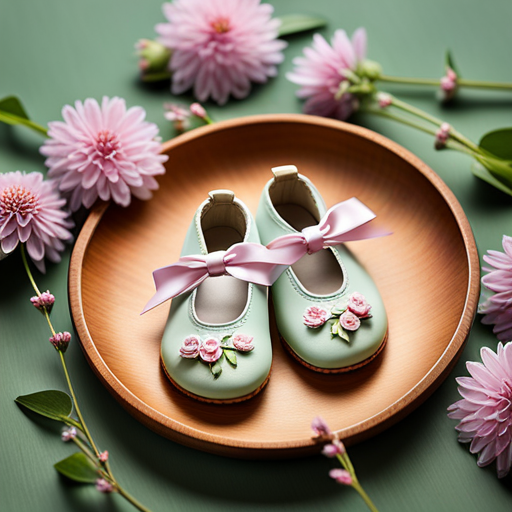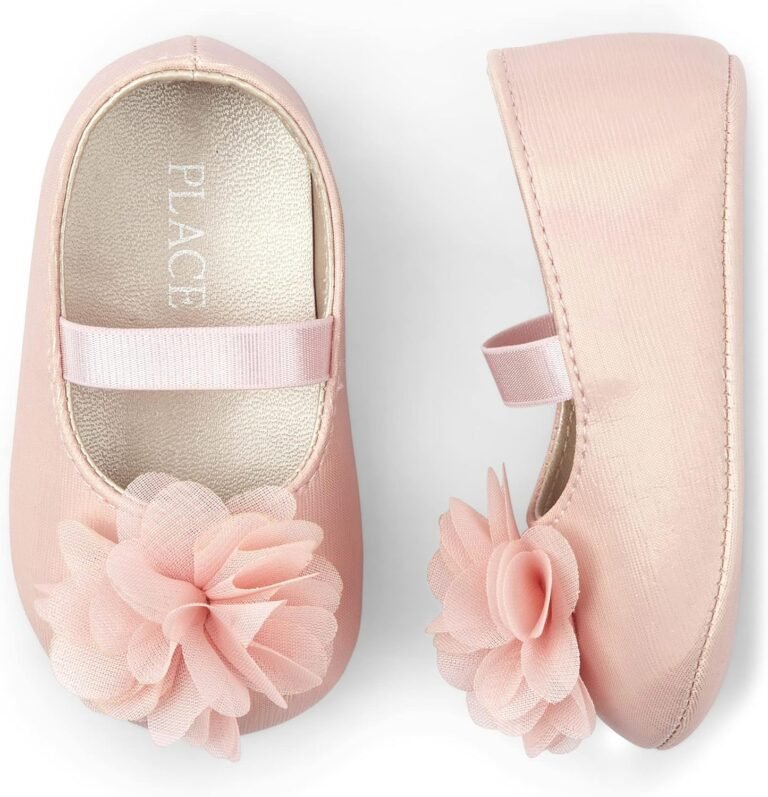Baby Shoes First Walkers
Step into a world of excitement as your little one takes their first steps with the perfect pair of first walker shoes.
These tiny shoes, like a gentle guiding hand, provide both comfort and support, ensuring your baby’s safety and confidence as they navigate their newfound mobility.
With our expert recommendations and insightful tips, you’ll discover the best options to cherish your baby’s delicate feet and make their first walking experience a joyous and memorable one.
Let’s embark on this journey together, serving your little one’s needs with care and expertise.
Key Takeaways
- First walker shoes promote healthy foot development
- Flexible soles mimic barefoot experience for balance and coordination
- Provide protection from potential hazards and injuries
- Look for shoes with flexibility, stability, and breathability
The Importance of First Walker Shoes
In order to ensure proper development and support for their growing feet, parents should carefully consider investing in high-quality first walker shoes for their infants. The importance of proper footwear cannot be overstated, as it plays a vital role in promoting healthy foot development and providing necessary protection.
First walker shoes are specifically designed to accommodate the unique needs of young children who are just starting to explore their surroundings. These shoes offer several benefits that contribute to the overall well-being of infants.
One of the key advantages of first walker shoes is their flexible soles. Unlike rigid and stiff shoes, these footwear options allow for natural movement and flexibility, mimicking the barefoot experience. This is crucial for the development of balance and coordination skills, as it allows infants to grip the floor and adjust their steps accordingly.
Additionally, the flexible soles of first walker shoes promote proper muscle development and strength in the feet. As infants take their first steps, their muscles are still developing, and the right footwear can provide the necessary support and stability to aid this process.
Moreover, proper footwear can protect infants’ feet from potential hazards and injuries. The sturdy construction and cushioning of first walker shoes shield delicate feet from sharp objects, uneven surfaces, and extreme temperatures.
When to Start Shopping for First Walker Shoes
Parents should consider shopping for their child’s first walker shoes around the age of 9-12 months, as this is typically when most infants begin to take their first steps and require the proper footwear for support and development. Shopping for first walker shoes at the right time is crucial for the child’s comfort and safety.
When it comes to shopping for first walker shoes, there are several popular brands that offer a wide range of options. Some of the most well-known brands include Stride Rite, Robeez, and Pediped. These brands are known for their quality, durability, and supportive features that are essential for a child’s growing feet.
When choosing the right shoes for your child, it is important to consider factors such as the shoe’s flexibility, stability, and breathability. Look for shoes made from soft, flexible materials that allow for natural movement and growth of the feet. Additionally, opt for shoes with good traction and support to help prevent slips and falls.
It is also worth mentioning that every child is different, and their feet may grow at different rates. It is recommended to have your child’s feet measured by a professional before purchasing first walker shoes. This ensures that you select the right size and fit for your child’s feet, promoting proper development and comfort.
Sizing and Fit: Finding the Perfect Pair
To ensure optimal comfort and support for your child’s developing feet, it is crucial to carefully consider the sizing and fit when searching for the perfect pair of first walker shoes.
Finding the right size is essential to provide enough room for growth and flexibility. When it comes to selecting the right size, it is advisable to measure your child’s feet regularly, as their size can change rapidly during their early years. A good rule of thumb is to leave about half an inch of space between your child’s longest toe and the front of the shoe. This allows for proper foot movement and prevents discomfort or restriction.
Considering growth and flexibility is also important when choosing first walker shoes. Children’s feet grow rapidly, and their shoes need to accommodate this growth. Look for shoes with adjustable closures, such as Velcro straps or laces, as they can provide a more customized fit. Additionally, shoes made from flexible materials, like soft leather or mesh, allow for natural movement and help prevent any restrictions on their developing feet.
When shopping for first walker shoes, it is recommended to take your child along to try on different pairs, as their comfort and fit may vary. Remember, the right size and fit are crucial to support your child’s feet as they take their first steps towards independence and exploration.
Features to Look for in First Walker Shoes
Durability and flexibility are key features to look for in first walker shoes, as they ensure long-lasting support and unrestricted movement for your child’s developing feet. When choosing the right brand, it is important to consider the following factors:
- Quality materials: Opt for shoes made from durable materials such as leather or canvas, as they can withstand the wear and tear of active toddlers.
- Supportive soles: Look for shoes with sturdy, yet flexible soles that provide adequate support for your child’s growing feet.
- Adjustable closures: Shoes with adjustable closures, such as Velcro straps or elastic laces, allow for a secure fit and easy on/off access.
Finding affordable options doesn’t mean compromising on quality. Consider the following tips:
- Shop sales and discounts: Keep an eye out for promotions and sales to snag a great deal on first walker shoes.
- Consider second-hand options: Check out consignment stores or online marketplaces for gently-used shoes that are still in good condition.
- Look for budget-friendly brands: Many reputable brands offer affordable options without sacrificing quality.
Choosing the Right Material for Baby’s Comfort
When considering the right material for baby’s comfort, it is important to prioritize the softness and breathability of the fabric to ensure optimal comfort for your little one. Babies have delicate skin that is more prone to irritation and rashes, so choosing the right material for their clothes, bedding, and accessories is crucial.
One of the key factors to consider when choosing the material is durability and longevity. Babies grow quickly, and their clothes need to withstand frequent washes and wear. Investing in high-quality, durable materials will ensure that the items last longer, saving you money in the long run.
To help you make an informed decision, here is a table highlighting some popular materials for baby clothing and their characteristics:
| Material | Softness | Breathability | Durability |
|---|---|---|---|
| Cotton | High | High | Medium |
| Bamboo | Very High | High | High |
| Organic | High | High | High |
| Polyester | Low | Low | High |
As you can see, cotton is a popular choice due to its softness and breathability, although it may not be as durable as other materials. Bamboo and organic fabrics offer excellent softness, breathability, and durability. Polyester, on the other hand, may not be as soft or breathable but is highly durable.
Support and Stability: Ensuring Proper Development
Proper support and stability are crucial for a baby’s development, as they help in strengthening their muscles and promoting balance. One way to ensure this is by choosing the right footwear for your little one. Proper footwear plays a significant role in supporting a baby’s feet and aiding in their overall development.
When it comes to choosing the right shoes for your baby, it is important to consider the benefits of barefoot walking:
-
Sensory Development: Walking barefoot allows babies to feel different textures and surfaces, stimulating their sensory development and enhancing their ability to perceive the world around them.
-
Muscle Strength: Walking without shoes helps babies develop stronger and more flexible muscles in their feet and legs, leading to better balance and coordination.
-
Natural Foot Development: Shoes can restrict the natural movement and growth of a baby’s feet. Barefoot walking allows their feet to develop naturally, without any hindrance from stiff soles or incorrect shoe sizes.
By providing your baby with ample opportunities for barefoot walking, you can contribute to their overall physical development.
However, it’s important to note that proper footwear is still necessary for protection in certain environments. When it comes to baby shoes, opt for soft-soled shoes or flexible shoes that mimic the feeling of being barefoot, providing support and protection without compromising their natural foot development.
Easy On, Stay On: Velcro Vs. Laces
One advantage of Velcro closures over laces is the ease of use, allowing parents to quickly and effortlessly secure their baby’s shoes. Velcro closures consist of two strips, one with tiny hooks and the other with loops, which easily stick together when pressed. This eliminates the need for time-consuming lacing and relacing, especially when dealing with a wriggling baby.
In terms of convenience, Velcro closures offer a quick and hassle-free option for parents. They allow for easy on and off, making it simple to put shoes on a baby’s feet and take them off without any struggles. This is particularly beneficial for busy parents who are always on the go and need a quick solution.
Let’s compare the pros and cons of Velcro closures and laces in the table below:
| Velcro Closures | Laces | |
|---|---|---|
| Pros | – Easy to use and secure | – Adjustable fit |
| – Quick on and off | – Traditional, classic look | |
| – Ideal for wriggling babies | – More secure | |
| Cons | – Can wear out over time | – Time-consuming |
| – Less secure than laces | – Require constant retying |
Stylish and Safe: Design Considerations
Designers must carefully consider both style and safety when creating baby shoes, ensuring that the design not only looks good but also provides the necessary support and protection for little feet.
As parents, we want our babies to look stylish and cute, but we also want to ensure that the shoes we choose are durable and will last for a long time.
When it comes to design trends in baby shoes, there is a growing demand for shoes that mimic adult styles. From miniature sneakers to tiny loafers, designers are creating shoes that not only look fashionable but also provide the necessary support for growing feet. This allows parents to dress their babies in stylish footwear without compromising on safety.
Durability is another crucial factor in baby shoe design. Babies are constantly on the move, exploring their surroundings and taking their first steps. Therefore, it is essential that the shoes are made from high-quality materials that can withstand the wear and tear of daily use. Shoes with reinforced toe caps and non-slip soles are particularly important to ensure the safety of little ones.
Longevity is also a consideration for parents when choosing baby shoes. Babies grow quickly, so it is essential that the shoes have adjustable features such as elastic or Velcro straps to accommodate their changing foot size. Additionally, shoes that are easy to clean and maintain can prolong their lifespan, making them a more cost-effective and sustainable choice.
Top Recommendations for First Walker Shoes
Based on extensive research and expert advice, three top recommendations for first walker shoes include supportive ankle and arch support, flexible soles for natural movement, and a lightweight design for optimal comfort. When it comes to choosing the best shoes for babies who are learning to walk, parents often turn to trusted baby shoe brands that prioritize safety and comfort. Some popular brands known for their quality and durability in this category are Stride Rite, Robeez, and Pediped. These brands have a range of options that meet the recommended criteria for first walker shoes.
In addition to the technical aspects of the shoe, the color of the shoe is also an important consideration. While there are no specific rules regarding the best colors for first walker shoes, many parents prefer lighter shades such as pastels or neutral tones. These colors tend to be versatile and can easily match different outfits. Additionally, lighter colors may show less visible dirt and scuff marks, making them easier to maintain. Ultimately, the choice of color is a personal preference and should be based on what the parents find aesthetically pleasing.
Table: Top Baby Shoe Brands
| Brand | Features |
|---|---|
| Stride Rite | Supportive, flexible, lightweight |
| Robeez | Soft soles, easy to put on |
| Pediped | Arch support, breathable materials |
Caring for Baby’s First Walker Shoes
When it comes to caring for baby’s first walker shoes, parents should be mindful of proper cleaning techniques and storage to ensure their longevity. Taking care of these tiny shoes not only helps to maintain their appearance but also ensures that they provide the necessary support and comfort for your little one’s growing feet.
Here are some cleaning tips to keep in mind:
-
Regular cleaning: Baby shoes can accumulate dirt, dust, and stains easily. It is important to clean them regularly to prevent any build-up that might damage the material or cause discomfort to your baby.
-
Gentle hand washing: Baby shoes are often made of delicate materials, so it is best to hand wash them using a mild detergent and warm water. Avoid using harsh chemicals or bleach as they can damage the fabric.
-
Air drying: After cleaning, allow the shoes to air dry naturally. Avoid using a dryer or direct heat as it can shrink or deform the shoes.
-
Proper storage: When not in use, store the shoes in a cool and dry place to prevent moisture damage. You can use shoe bags or boxes to keep them protected and organized.
Frequently Asked Questions
How Long Does It Take for Babies to Start Walking After Wearing First Walker Shoes?
The time it takes for babies to start walking after wearing first walker shoes can vary. Factors such as individual development, motor skills, and exposure to outdoor activities play a role in this milestone.
Are First Walker Shoes Necessary for a Baby’s Development or Can They Go Barefoot?
The benefits of a baby going barefoot include improved balance, muscle strength, and sensory development. Soft soled shoes can provide protection while allowing for natural foot movement. However, first walker shoes can offer additional support and stability.
Can First Walker Shoes Be Used for Outdoor Activities or Are They Only Meant for Indoor Use?
First walker shoes can indeed be used for outdoor activities, providing support and protection for babies as they explore their environment. These shoes offer benefits such as stability and grip, ensuring a safe and comfortable experience for little ones.
How Often Should the Sizing of First Walker Shoes Be Checked and Updated as the Baby Grows?
It is crucial to regularly check and update the sizing of baby shoes as they grow. Proper fitting is vital for their comfort and development. Parents should ensure that the shoes provide adequate support and allow for natural foot movement.
Are There Any Specific Cleaning Instructions for Maintaining the Quality of Baby’s First Walker Shoes?
When it comes to maintaining the quality of baby’s first walker shoes, it is important to follow specific cleaning instructions. Proper care will depend on the materials used in the shoes and best practices for cleaning baby shoes.
Conclusion
In conclusion, finding the perfect pair of first walker shoes for your baby is crucial for their comfort and development.
By considering factors such as sizing, fit, material, closures, and design, you can ensure that your little one’s feet are protected and supported as they take their first steps.
So, why wait? Start shopping for first walker shoes today and give your baby the best start on their walking journey.








